Define entropy. Why is it a state function? Explain the effect of increased temperature on the entropy of a substance.
Step-by-Step Solution:
Step 1: Define Entropy
Entropy is a thermodynamic quantity that measures the degree of disorder or randomness in a system. It is often denoted by the symbol S. In simple terms, the higher the entropy, the greater the disorder and the more ways the energy can be distributed among the particles in a system.
Step 2: Explain Why Entropy is a State Function
A state function is a property that depends only on the current state of the system, not on the path taken to reach that state. Entropy is considered a state function because its value is determined solely by the state of the system (such as temperature, pressure, and volume) and not by how the system arrived at that state. For example, whether a system is in a solid, liquid, or gas phase, the entropy can be calculated based on its current conditions without regard to the process that led to that state.
Step 3: Explain the Effect of Increased Temperature on Entropy
As the temperature of a substance increases, the kinetic energy of its particles also increases. This increase in energy leads to greater molecular motion and a higher degree of disorder within the substance. Consequently, the entropy of the substance increases. For instance, when a solid is heated and melts into a liquid, or when a liquid is heated and vaporizes into a gas, the entropy increases significantly due to the increased freedom of movement of the particles in the higher energy states.
Entropy is a thermodynamic quantity that measures the degree of disorder or randomness in a system. It is often denoted by the symbol S. In simple terms, the higher the entropy, the greater the disorder and the more ways the energy can be distributed among the particles in a system.
A state function is a property that depends only on the current state of the system, not on the path taken to reach that state. Entropy is considered a state function because its value is determined solely by the state of the system (such as temperature, pressure, and volume) and not by how the system arrived at that state. For example, whether a system is in a solid, liquid, or gas phase, the entropy can be calculated based on its current conditions without regard to the process that led to that state.
As the temperature of a substance increases, the kinetic energy of its particles also increases. This increase in energy leads to greater molecular motion and a higher degree of disorder within the substance. Consequently, the entropy of the substance increases. For instance, when a solid is heated and melts into a liquid, or when a liquid is heated and vaporizes into a gas, the entropy increases significantly due to the increased freedom of movement of the particles in the higher energy states.
Topper's Solved these Questions
- BOOK - PRADEEPCHAPTER - THERMODYNAMICSEXERCISE - ADDITIONAL QUESTIONS(VERY SHORT ANSWER QUESTIONS)43videos
THERMODYNAMICS
- BOOK - PRADEEPCHAPTER - THERMODYNAMICSEXERCISE - SHORT ANSWER QUESTIONS65videos
THERMODYNAMICS
- BOOK - PRADEEPCHAPTER - THERMODYNAMICSEXERCISE - ASSERTION AND REACTION TYPES QUESTIONS3videos
THERMODYNAMICS
- BOOK - PRADEEPCHAPTER - STRUCTURE OF ATOMEXERCISE - Competition Focus (JEE (Main and Advanced)/Medical Entrance (IX. Assertion And Reason Type Questions (Type II))12videos
STRUCTURE OF ATOM
Similar Questions
Knowledge Check
- Question 1 - Select One
Energy is associated with the orientation and distribution of molecules in space. Disordered crystals have higher entropy than ordered crystals and diffused gases have higher entropy than compressed gases.
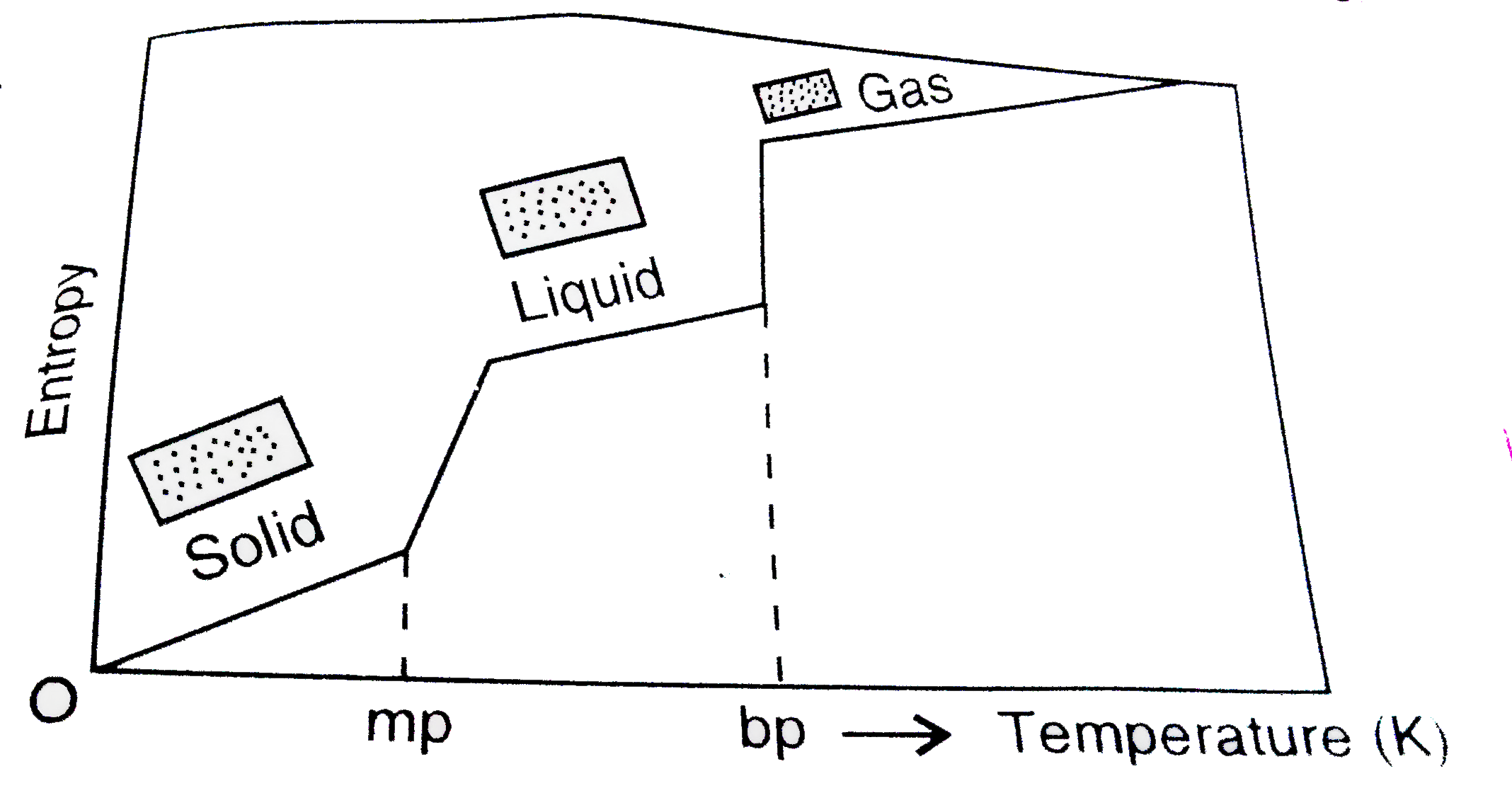
Entropy is also associated with molecular motion. As the temperature of a substance increases, random molecular motion increases hence entropy increases. Figure gives variation of entropy with temperature. At absolute zero (−273∘C) every substance is in solid state whose particles are rigidly fixed in a crystalline structure. If there is no residual orientational disorder, like that in CO, entropy of the substance is zero. Third law of thermodynamics states.
At the absolute zero of temperature the entropy of every substance become zero and does become zero in case of perfectly crystalline structure.
understand(T→0)(LtS)=0
In case of CO and NO molecules in solid state, there is randomness even at 0K due to their dipole moments hence entropy in such cases is not zero even at 0K. As the temperature is raised, the molecules begin to vibrate. The number of ways in which the vibrational energy can be distributed increases with increases in temperature and the entropy of solid increases steadily as the temperature increaes. At the melting point (mp) of the solid, there is a discontinous jump in entropy because there are many more ways of arranging the molecules in the liquid than in the solid. An even greater jump in entropy is observed at the boiling point (bp) because molecules in the gas are to free to occupy a more larger volume and randomness increases.
Which has the highest entropy per mol of the substance ?AH2 at 25∘C at 1 atmBH2 at STPCH2 at 100K at 1 atmDH_(2)at0 Kat1 atm - Question 2 - Select One
Energy is associated with the orientation and distribution of molecules in space. Disordered crystals have higher entropy than ordered crystals and diffused gases have higher entropy than compressed gases.
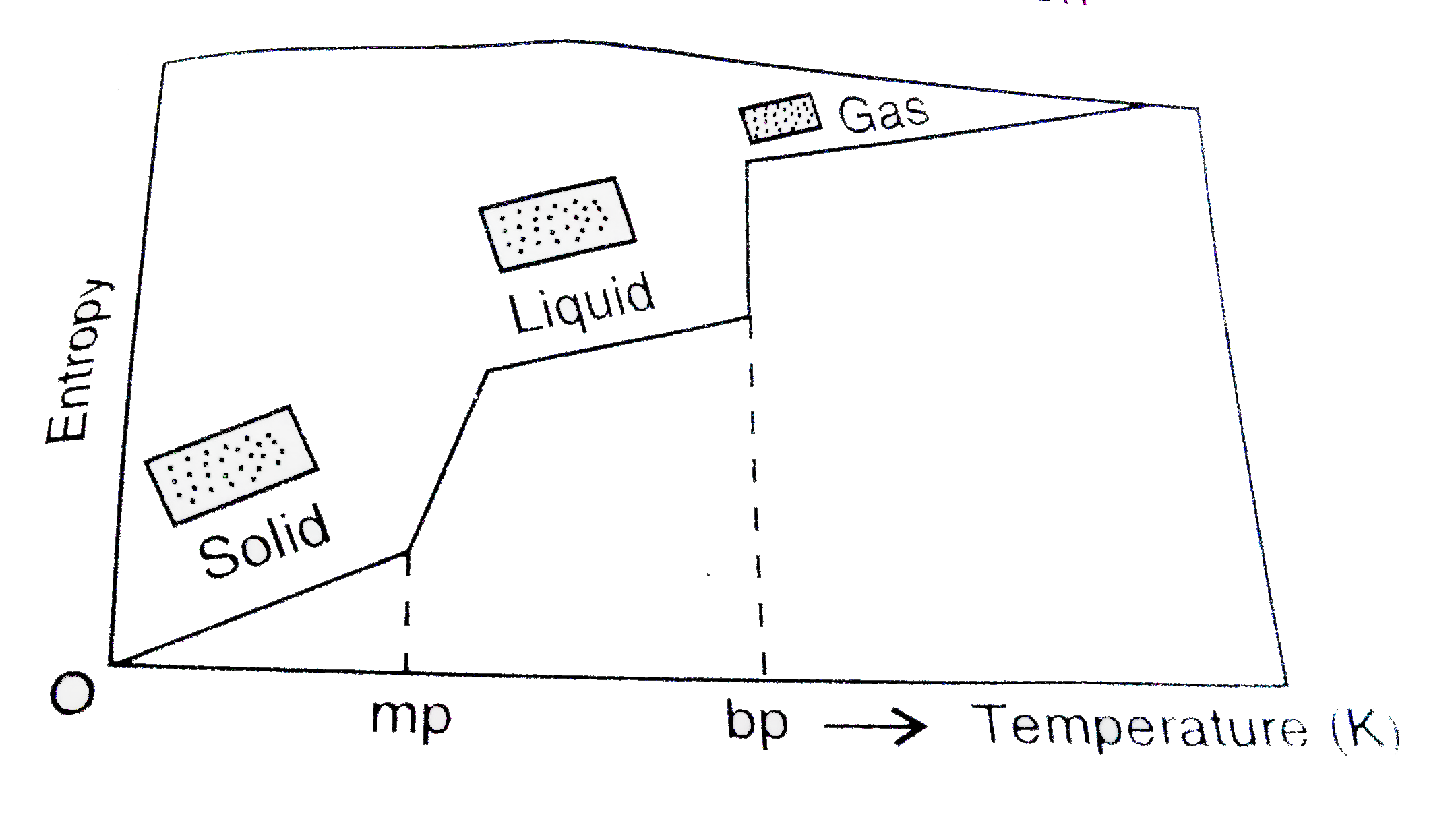
Entropy is also associated with molecular motion. As the temperature of a substance increases, random molecular motion increases hence entropy increases. Figure gives variation of entropy with temperature. At absolute zero (−273∘C) every substance is in solid state whose particles are rigidly fixed in a crystalline structure. If there is no residual orientational disorder, like that in CO, entropy of the substance is zero. Third law of thermodynamics states.
At the absolute zero of temperature the entropy of every substance become zero and does become zero in case of perfectly crystalline structure.
understand(T→0)(LtS)=0
In case of CO and NO molecules in solid state, there is randomness even at 0K due to their dipole moments hence entropy in such cases is not zero even at 0K. As the temperature is raised, the molecules begin to vibrate. The number of ways in which the vibrational energy can be distributed increases with increases in temperature and the entropy of solid increases steadily as the temperature increaes. At the melting point (mp) of the solid, there is a discontinous jump in entropy because there are many more ways of arranging the molecules in the liquid than in the solid. An even greater jump in entropy is observed at the boiling point (bp) because molecules in the gas are to free to occupy a more larger volume and randomness increases.
Which has maximum entropy of vaporisation ?AEthanol (l)BBenzene (l)CToluene (l)DCO2(g) - Question 3 - Select One
Energy is associated with the orientation and distribution of molecules in space. Disordered crystals have higher entropy than ordered crystals and diffused gases have higher entropy than compressed gases.

Entropy is also associated with molecular motion. As the temperature of a substance increases, random molecular motion increases hence entropy increases. Figure gives variation of entropy with temperature. At absolute zero (−273∘C) every substance is in solid state whose particles are rigidly fixed in a crystalline structure. If there is no residual orientational disorder, like that in CO, entropy of the substance is zero. Third law of thermodynamics states.
At the absolute zero of temperature the entropy of every substance become zero and does become zero in case of perfectly crystalline structure.
understand(T→0)(LtS)=0
In case of CO and NO molecules in solid state, there is randomness even at 0K due to their dipole moments hence entropy in such cases is not zero even at 0K. As the temperature is raised, the molecules begin to vibrate. The number of ways in which the vibrational energy can be distributed increases with increases in temperature and the entropy of solid increases steadily as the temperature increaes. At the melting point (mp) of the solid, there is a discontinous jump in entropy because there are many more ways of arranging the molecules in the liquid than in the solid. An even greater jump in entropy is observed at the boiling point (bp) because molecules in the gas are to free to occupy a more larger volume and randomness increases.
For the following reaction
CaCO3(s)→CaO(s)+CO2(g)
If at 0K, ΔS of this reaction is Xcalmol−1 then entropy of CO2(g) at 0K isA−XcalB−2XcalC+XcalD0cal
Define free energy and entropy of a system.
View SolutionExplain the term residual entropy.
View SolutionEnergy is associated with the orientation and distribution of molecules in space. Disordered crystals have higher entropy than ordered crystals and diffused gases have higher entropy than compressed gases.
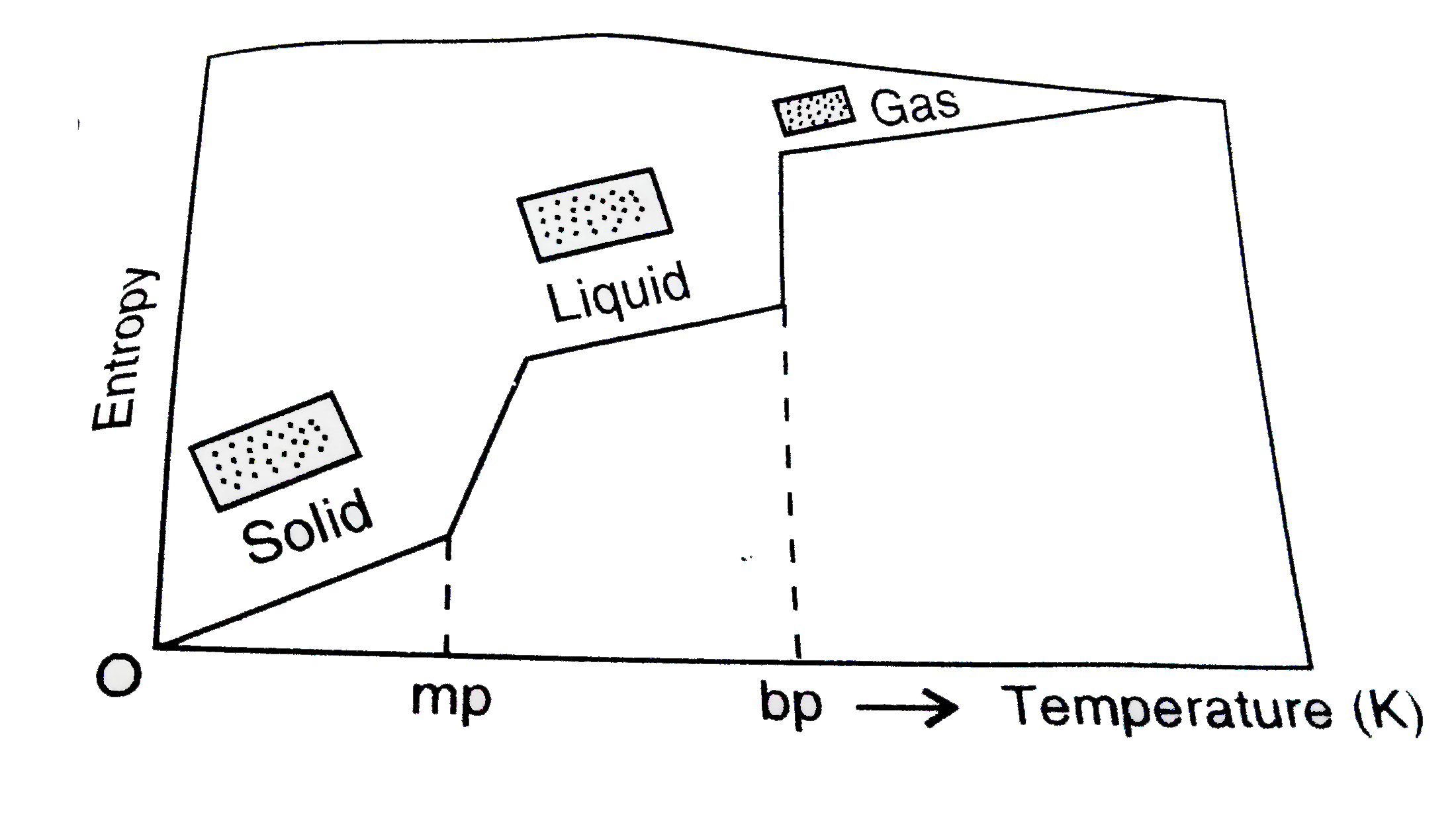
Entropy is also associated with molecular motion. As the temperature of a substance increases, random molecular motion increases hence entropy increases. Figure gives variation of entropy with temperature. At absolute zero (−273∘C) every substance is in solid state whose particles are rigidly fixed in a crystalline structure. If there is no residual orientational disorder, like that in CO, entropy of the substance is zero. Third law of thermodynamics states.
At the absolute zero of temperature the entropy of every substance become zero and does become zero in case of perfectly crystalline structure.
understand(T→0)(LtS)=0
In case of CO and NO molecules in solid state, there is randomness even at 0K due to their dipole moments hence entropy in such cases is not zero even at 0K. As the temperature is raised, the molecules begin to vibrate. The number of ways in which the vibrational energy can be distributed increases with increases in temperature and the entropy of solid increases steadily as the temperature increaes. At the melting point (mp) of the solid, there is a discontinous jump in entropy because there are many more ways of arranging the molecules in the liquid than in the solid. An even greater jump in entropy is observed at the boiling point (bp) because molecules in the gas are to free to occupy a more larger volume and randomness increases.
Which of the following process is spontaneous?View SolutionEnergy is associated with the orientation and distribution of molecules in space. Disordered crystals have higher entropy than ordered crystals and diffused gases have higher entropy than compressed gases.
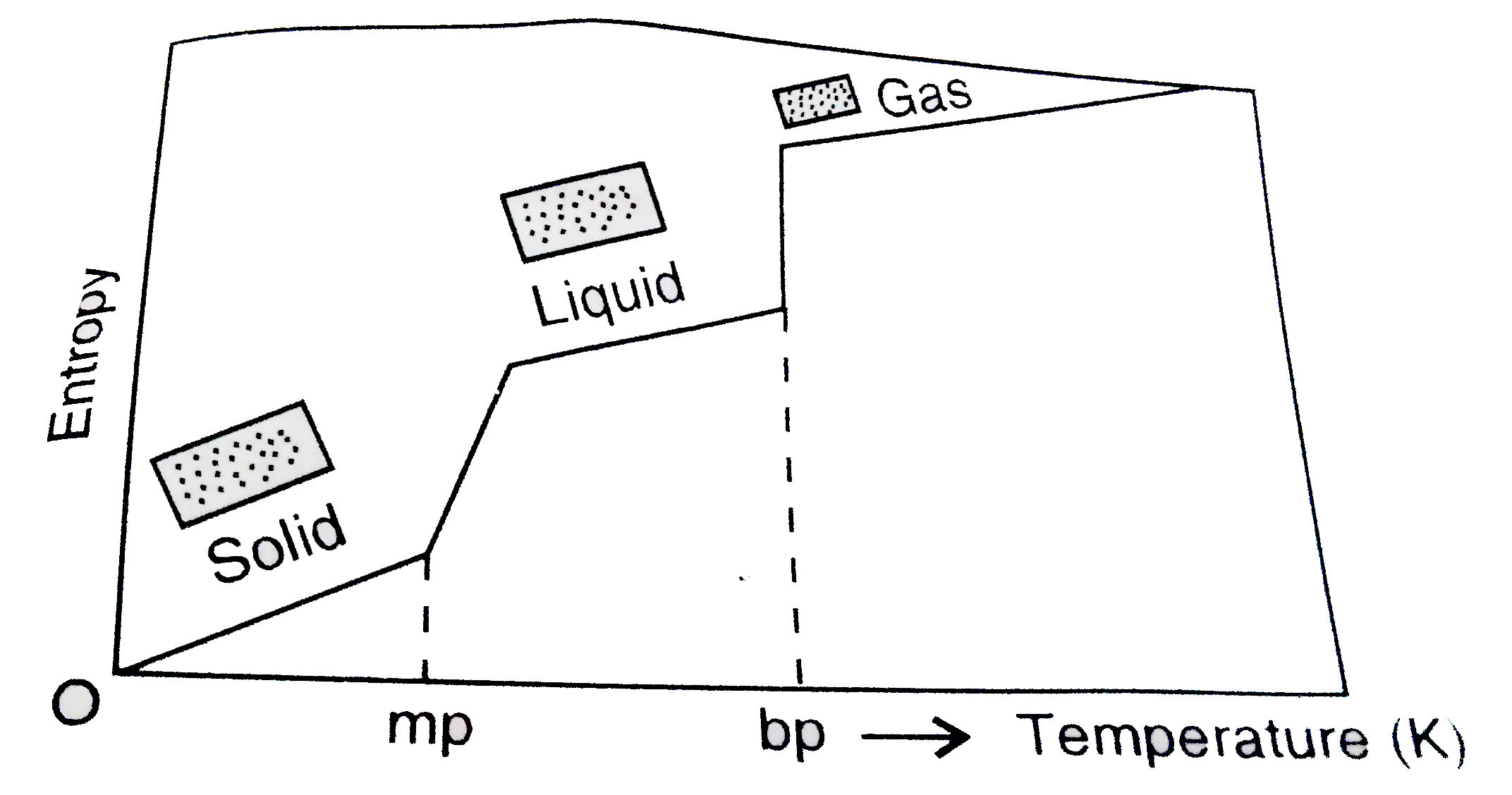
Entropy is also associated with molecular motion. As the temperature of a substance increases, random molecular motion increases hence entropy increases. Figure gives variation of entropy with temperature. At absolute zero (−273∘C) every substance is in solid state whose particles are rigidly fixed in a crystalline structure. If there is no residual orientational disorder, like that in CO, entropy of the substance is zero. Third law of thermodynamics states.
At the absolute zero of temperature the entropy of every substance become zero and does become zero in case of perfectly crystalline structure.
understand(T→0)(LtS)=0
In case of CO and NO molecules in solid state, there is randomness even at 0K due to their dipole moments hence entropy in such cases is not zero even at 0K. As the temperature is raised, the molecules begin to vibrate. The number of ways in which the vibrational energy can be distributed increases with increases in temperature and the entropy of solid increases steadily as the temperature increaes. At the melting point (mp) of the solid, there is a discontinous jump in entropy because there are many more ways of arranging the molecules in the liquid than in the solid. An even greater jump in entropy is observed at the boiling point (bp) because molecules in the gas are to free to occupy a more larger volume and randomness increases.
Out of the following statements : I, II and III. I . A system may be a complex as a human body as simple as a mixture consiting of a drop of water.
II. A large system is said to be microscopic when it consists of a large number of molecules, atoms or ions.
III. Pressure, volume, temperature and surface area are some macroscopic properties.
Select correct statementsView SolutionEnergy is associated with the orientation and distribution of molecules in space. Disordered crystals have higher entropy than ordered crystals and diffused gases have higher entropy than compressed gases.
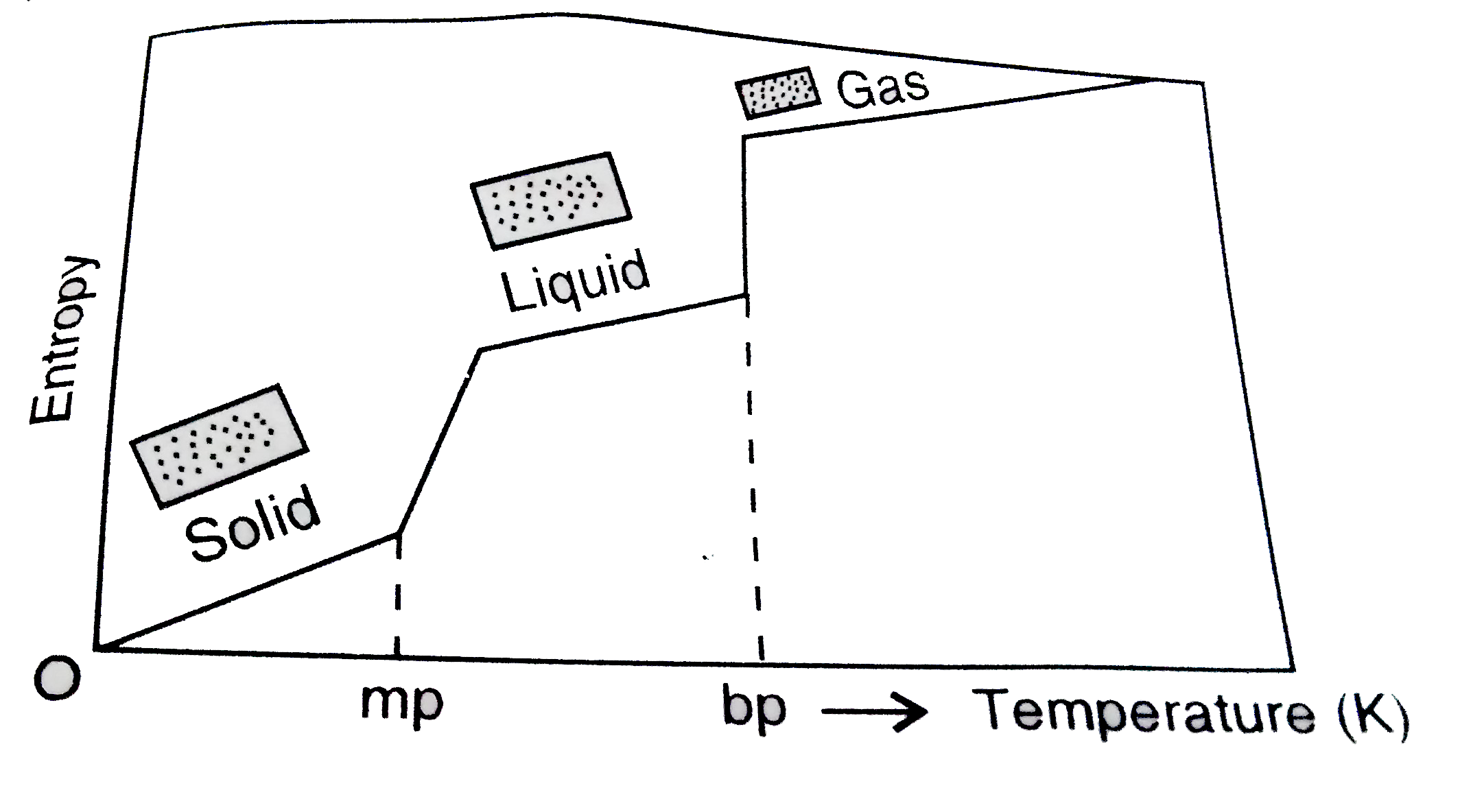
Entropy is also associated with molecular motion. As the temperature of a substance increases, random molecular motion increases hence entropy increases. Figure gives variation of entropy with temperature. At absolute zero (−273∘C) every substance is in solid state whose particles are rigidly fixed in a crystalline structure. If there is no residual orientational disorder, like that in CO, entropy of the substance is zero. Third law of thermodynamics states.
At the absolute zero of temperature the entropy of every substance become zero and does become zero in case of perfectly crystalline structure.
understand(T→0)(LtS)=0
In case of CO and NO molecules in solid state, there is randomness even at 0K due to their dipole moments hence entropy in such cases is not zero even at 0K. As the temperature is raised, the molecules begin to vibrate. The number of ways in which the vibrational energy can be distributed increases with increases in temperature and the entropy of solid increases steadily as the temperature increaes. At the melting point (mp) of the solid, there is a discontinous jump in entropy because there are many more ways of arranging the molecules in the liquid than in the solid. An even greater jump in entropy is observed at the boiling point (bp) because molecules in the gas are to free to occupy a more larger volume and randomness increases.
Predict the sign of ΔS in the system for each of the following process
(I)CO2(s)→CO2(g)
(II)CaSO4(s)→CaO(s)+SO3(g)
(III)N2(g)+3H2(g)→2NH3(g)
(IV)I2(s)→I2(aq)View Solution

